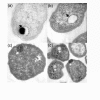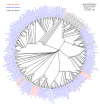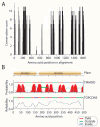Evolution of vacuolar proton pyrophosphatase domains and volutin granules: clues into the early evolutionary origin of the acidocalcisome
- PMID: 21974828
- PMCID: PMC3198990
- DOI: 10.1186/1745-6150-6-50
Evolution of vacuolar proton pyrophosphatase domains and volutin granules: clues into the early evolutionary origin of the acidocalcisome
Abstract
Background: Volutin granules appear to be universally distributed and are morphologically and chemically identical to acidocalcisomes, which are electron-dense granular organelles rich in calcium and phosphate, whose functions include storage of phosphorus and various metal ions, metabolism of polyphosphate, maintenance of intracellular pH, osmoregulation and calcium homeostasis. Prokaryotes are thought to differ from eukaryotes in that they lack membrane-bounded organelles. However, it has been demonstrated that as in acidocalcisomes, the calcium and polyphosphate-rich intracellular "volutin granules (polyphosphate bodies)" in two bacterial species, Agrobacterium tumefaciens, and Rhodospirillum rubrum, are membrane bound and that the vacuolar proton-translocating pyrophosphatases (V-H+PPases) are present in their surrounding membranes. Volutin granules and acidocalcisomes have been found in organisms as diverse as bacteria and humans.
Results: Here, we show volutin granules also occur in Archaea and are, therefore, present in the three superkingdoms of life (Archaea, Bacteria and Eukarya). Molecular analyses of V-H+PPase pumps, which acidify the acidocalcisome lumen and are diagnostic proteins of the organelle, also reveal the presence of this enzyme in all three superkingdoms suggesting it is ancient and universal. Since V-H+PPase sequences contained limited phylogenetic signal to fully resolve the ancestral nodes of the tree, we investigated the divergence of protein domains in the V-H+PPase molecules. Using Protein family (Pfam) database, we found a domain in the protein, PF03030. The domain is shared by 31 species in Eukarya, 231 in Bacteria, and 17 in Archaea. The universal distribution of the V-H+PPase PF03030 domain, which is associated with the V-H+PPase function, suggests the domain and the enzyme were already present in the Last Universal Common Ancestor (LUCA).
Conclusion: The importance of the V-H+PPase function and the evolutionary dynamics of these domains support the early origin of the acidocalcisome organelle. In particular, the universality of volutin granules and presence of a functional V-H+PPase domain in the three superkingdoms of life reveals that the acidocalcisomes may have appeared earlier than the divergence of the superkingdoms. This result is remarkable and highlights the possibility that a high degree of cellular compartmentalization could already have been present in the LUCA.
Figures



Similar articles
-
Cloning and functional expression of a gene encoding a vacuolar-type proton-translocating pyrophosphatase from Trypanosoma cruzi.Biochem J. 2000 Oct 1;351(Pt 1):281-8. doi: 10.1042/0264-6021:3510281. Biochem J. 2000. PMID: 10998372 Free PMC article.
-
The H(+)-pyrophosphatase of Rhodospirillum rubrum is predominantly located in polyphosphate-rich acidocalcisomes.J Biol Chem. 2004 Dec 3;279(49):51193-202. doi: 10.1074/jbc.M406099200. Epub 2004 Sep 15. J Biol Chem. 2004. PMID: 15371423
-
The origin and evolution of the acidocalcisome and its interactions with other organelles.Mol Biochem Parasitol. 2016 Sep-Oct;209(1-2):3-9. doi: 10.1016/j.molbiopara.2015.10.003. Epub 2015 Oct 30. Mol Biochem Parasitol. 2016. PMID: 26523947 Free PMC article. Review.
-
Polyphosphate and acidocalcisomes.Biochem Soc Trans. 2016 Feb;44(1):1-6. doi: 10.1042/BST20150193. Biochem Soc Trans. 2016. PMID: 26862180 Free PMC article. Review.
-
Acidocalcisomes and Polyphosphate Granules Are Different Subcellular Structures in Agrobacterium tumefaciens.Appl Environ Microbiol. 2020 Apr 1;86(8):e02759-19. doi: 10.1128/AEM.02759-19. Print 2020 Apr 1. Appl Environ Microbiol. 2020. PMID: 32060025 Free PMC article.
Cited by
-
Arabidopsis type I proton-pumping pyrophosphatase expresses strongly in phloem, where it is required for pyrophosphate metabolism and photosynthate partitioning.Plant Physiol. 2015 Apr;167(4):1541-53. doi: 10.1104/pp.114.254342. Epub 2015 Feb 13. Plant Physiol. 2015. PMID: 25681328 Free PMC article.
-
On the potential roles of phosphorus in the early evolution of energy metabolism.Front Microbiol. 2023 Aug 2;14:1239189. doi: 10.3389/fmicb.2023.1239189. eCollection 2023. Front Microbiol. 2023. PMID: 37601379 Free PMC article. Review.
-
Pyrophosphate-fueled Na+ and H+ transport in prokaryotes.Microbiol Mol Biol Rev. 2013 Jun;77(2):267-76. doi: 10.1128/MMBR.00003-13. Microbiol Mol Biol Rev. 2013. PMID: 23699258 Free PMC article. Review.
-
Molecular characterization and transcriptional regulation of two types of H+-pyrophosphatases in the scuticociliate parasite Philasterides dicentrarchi.Sci Rep. 2021 Apr 19;11(1):8519. doi: 10.1038/s41598-021-88102-0. Sci Rep. 2021. PMID: 33875762 Free PMC article.
-
From Rest to Growth: Life Collisions of Gordonia polyisoprenivorans 135.Microorganisms. 2022 Feb 18;10(2):465. doi: 10.3390/microorganisms10020465. Microorganisms. 2022. PMID: 35208919 Free PMC article.
References
-
- Margulis L. Symbiotic theory of the origin of eukaryotic organelles; criteria for proof. Symp Soc Exp Biol. 1975. pp. 21–38. - PubMed
-
- Martin W, Russell MJ. On the origins of cells: a hypothesis for the evolutionary transitions from abiotic geochemistry to chemoautotrophic prokaryotes, and from prokaryotes to nucleated cells. Philos Trans R Soc Lond B Biol Sci. 2003;358:59–83. doi: 10.1098/rstb.2002.1183. discussion 83-55. - DOI - PMC - PubMed
Publication types
MeSH terms
Substances
Grants and funding
LinkOut - more resources
Full Text Sources

